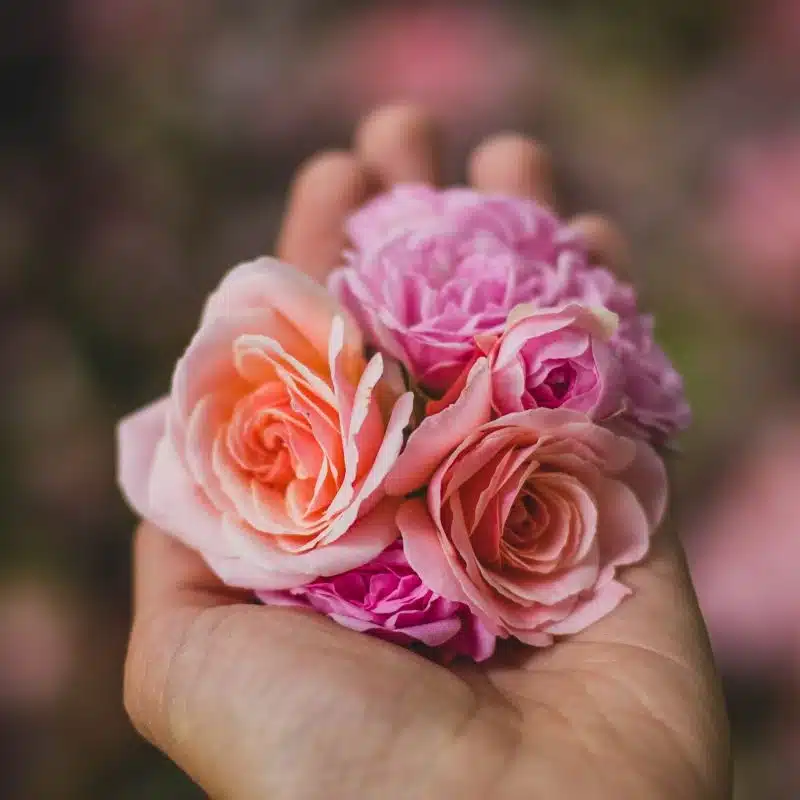Self care is essential for maintaining a healthy mind and body but have you ever wondered about adding a self love flower into your daily routine? Flowers are not only beautiful, but they also hold a deeper meaning and symbolism that can help boost self-esteem and confidence.
Before we jump into the list of self love flowers, let’s go over a fun topic – how flowers can improve your self care routine.
Can Flowers Improve Your Self Care Routine?
The short answer is yes – absolutely! Flower essences have been used for centuries as a powerful tool for promoting emotional and spiritual growth.
Their vibrant colors and sweet scents can evoke feelings of joy, happiness, and optimism. When you surround yourself with flowers, their positive energy can have a direct impact on your mood, creating a more positive mindset that supports self-esteem and confidence. Other benefits include:
- Mood enhancement: Flowers have a positive impact on mood and emotions. Their vibrant colors and pleasant scents can uplift your spirits, reduce stress, and improve overall well-being. Studies have shown that being around flowers can increase feelings of happiness, calmness, and relaxation.
- Stress reduction: The presence of flowers has been linked to a decrease in stress levels. The sight and scent of flowers can help lower blood pressure, reduce cortisol levels, and promote relaxation.
- Increased creativity and productivity: Studies have shown that having flowers or plants in work or study environments can enhance creativity, productivity, and concentration. Flowers can stimulate the brain and boost mental clarity, leading to improved performance in various tasks.
- Better sleep quality: Their scents can promote relaxation, reduce anxiety, and improve sleep quality. Placing these flowers or using their essential oils in the bedroom can create a more conducive sleep environment.
- Enhanced healing and recovery: Research suggests that patients in hospital rooms with flowers or plants tend to experience faster recovery and require less pain medication. Flowers are with reduced anxiety and improve mood which can aid in the healing process.
- Increased connection with nature: Having flowers in your home allows you to bring a touch of nature indoors. Connecting with nature can reduce stress and improve overall well-being.
What Self Love Flower is Right For You?
Now, you can go out and choose any flower but what about flowers with symbolic meanings? Below is a list of some of our favorite self love flower options.
- Sweet Peas: These beautiful flowers come in a variety of colors and are a symbol of romantic love. They can also promote spiritual growth and be a reminder to take care of your own needs.
- White Lilies: These elegant flowers are a symbol of purity and are a great way to connect with your inner strength. They can also be a reminder to stay true to yourself and your own values.
- Pink Dahlia: This vibrant flower represents inner strength and can be a great way to promote self-confidence and self-acceptance. It can also help you connect with your true self and recognize your own value.
- Pink Carnation: This beautiful flower represents the positive qualities of a happy life, such as love, gratitude, and joy. It can also be a great way to promote positive emotions and self-confidence.
- Red Carnation: This beautiful bloom symbolizes pure love and can be a great way to promote self-love and self-acceptance. It can also help you connect with your own value and recognize your own worth.
- Sunflowers: Sunflowers are often seen as a symbol of confidence, positivity, and strength. Their vibrant yellow color and upward-facing blooms evoke a sense of optimism and empowerment. Having a bouquet of sunflowers or even a single sunflower in your living space can serve as a reminder of your own inner strength and beauty.
Self Love Flower List Continued
- Roses: Red roses aren’t just for Valentine’s day! They are known for their beauty and elegance, and they can also help uplift self-esteem. The classic red rose represents love and passion, while pink roses symbolize love, gratitude, and admiration. Displaying roses or using rose petals in your self-care routine can help evoke feelings of self-love and appreciation. These vibrant blooms symbolize new beginnings and are a great way to start your journey to self-love. Pink roses also represent unconditional love and are a perfect reminder that you are deserving of love and acceptance.
- Peonies: Peonies are often associated with grace, beauty, and self-confidence. Their lush, full blooms and delicate fragrance can inspire a sense of inner strength and confidence. Surrounding yourself with peonies, either as fresh flowers or in artwork, can be a visual reminder of your own inner beauty and worth.
- Orchids: Orchids are exotic and elegant flowers. Their intricate and unique blooms can symbolize strength, resilience, and grace. Having an orchid plant in your home or workspace can create a sense of sophistication and inspire confidence.
- Daisies: Daisies are simple and cheerful flowers that can help boost self-esteem. They represent purity, innocence, and optimism. The bright and open nature of daisies can remind you to approach life with a positive mindset and embrace your own unique qualities.
How Can I Add a Self Love Flower to My Self Care Routine?
Incorporating flowers into your self-care routine can be a beautiful and uplifting practice. Here are some ideas on how to do so:
- Flower-infused baths: Incorporate roses or flower petals into your bathwater for a luxurious and soothing experience.
- Aromatherapy with flowers: Use essential oils derived from flowers during aromatherapy sessions. Diffuse floral scents in your living space or create a floral-scented pillow spray for better sleep.
- Flower arrangements and displays: Surround yourself with bouquets or place potted plants in your living space.
- Flower essences: Flower essences are vibrational remedies made by infusing flowers in water and capturing their energetic imprint. They are believed to support emotional and spiritual well-being. Explore different flower essences and incorporate them into your daily self-care routine by adding a few drops to your drinking water.
- Creating a flower altar: Designate a small area in your home as a sacred space for flowers. Arrange a simple altar with a vase of fresh flowers, candles, crystals, and other meaningful objects.
- Mindful flower appreciation: Take time to observe and appreciate the beauty of flowers mindfully. Sit in a garden or park and allow yourself to be fully present with the colors, scents, and textures of the flowers. Practice deep breathing or meditation while focusing on the natural beauty around you.
- Herbal teas with floral blends: Brew teas with calming flowers like chamomile, lavender, or passionflower to promote relaxation and stress relief. Enjoy the soothing aroma and flavors as you take a mindful break.
Remember, the key is to approach these practices with intention and mindfulness. Allow yourself to fully immerse in the experience, savoring the beauty and healing energy that flowers can bring to your self-care routine. Now, if you want to get very specific – you can also choose colors by their flowers.
Color Meanings For All Flowers
Here is a list of common meanings for the colors of flowers. The interpretations of flower colors can vary across different belief systems, but here are some common associations:
- Red: Associated with passion, love, and vitality. They can symbolize strong emotions, courage, and life force energy. In some spiritual contexts, red flowers may represent the root chakra or be associated with fire and transformation.
- Pink: Associated with love, compassion, and tenderness. They can represent affection, nurturing, and gentle emotions. Pink is often connected to the heart chakra and the energy of love and healing.
- Yellow: Associated with joy, happiness, and positive energy. They can symbolize optimism, friendship, and spiritual growth. Yellow is also associated with the solar plexus chakra, representing personal power and confidence.
- Orange: Associated with enthusiasm, creativity, and vitality. They can represent passion, optimism, and a sense of adventure. Orange is often linked to the sacral chakra, which governs emotions, sensuality, and self-expression.
- Blue: Associated with tranquility, serenity, and spiritual awakening. They can symbolize peace, intuition, and inner wisdom. Blue is connected to the throat chakra, representing communication and self-expression.
- Purple: Associated with spirituality, higher consciousness, and transformation. They can symbolize wisdom, mysticism, and spiritual insight. Purple is often connected to the crown chakra, representing divine connection and spiritual enlightenment.
- White: Associated with purity, innocence, and spiritual illumination. They can represent spiritual growth, clarity, and transcendence. White is often linked to the crown chakra and the energy of divine love and wisdom.
It’s important to note that the interpretations of flower colors in a spiritual context can vary among different cultures, traditions, and personal beliefs. The meanings assigned to flowers are often subjective and can be influenced by individual experiences and cultural backgrounds.
Now that you’ve chosen your flowers, make sure you care for them!
How to Take Good Care of Your Flowers:
Caring for flowers properly can help them stay fresh, and vibrant, and last longer. Make sure to shower your self love flower or flowers in lots of love. Here are some tips for flower care:
- Watering: Keep your flowers hydrated by providing them with fresh water. Fill a clean vase with lukewarm water and change it every 1-2 days or whenever it becomes cloudy. Trim the stems at an angle before placing them in the water to facilitate better water absorption.
- Removing leaves: Remove any foliage or leaves that will be submerged in the water. Leaves in the water can promote bacterial growth and decrease the lifespan of the flowers.
- Trimming stems: Trim the stems of your flowers every few days, about half an inch to an inch, at an angle. This helps to create a fresh surface for water uptake and prevents the ends from sitting flat at the bottom of the vase.
- Proper placement: Place your flowers in a location away from direct sunlight, drafts, and heat sources. Exposure to direct sunlight and excessive heat can cause flowers to wilt faster. Keep them in a cool, well-ventilated area for optimal longevity.
- Flower food or preservatives: Use flower food or preservatives that often come with store-bought bouquets. These contain nutrients and ingredients that help extend the life of cut flowers. Follow the instructions provided for the appropriate dosage.
- Clean vases: Regularly clean your vases with warm, soapy water to remove any bacteria or residue that can affect the flowers’ lifespan. Rinse them thoroughly before adding fresh water and flowers.
- Flower-specific care: Different types of flowers may have specific care requirements. Research the specific needs of the flowers you have and follow any additional care instructions provided.
Final Thoughts
We hope you enjoyed reading this post on self love flower choices and that when you add flowers to your self care routine, your life is in full bloom.
Each flower holds a deeper meaning and symbolism that can help remind you of your inner beauty, strength, and resilience. Whether you choose roses, sunflowers, lavender, daisies, orchids, or peonies, incorporating flowers into your self-care routine can help improve your overall well-being. So go ahead and treat yourself to a beautiful bouquet or plant a flower garden, and watch your self-esteem bloom!
Leave us a comment and let us know what self love flower that you add to your self care routine!

